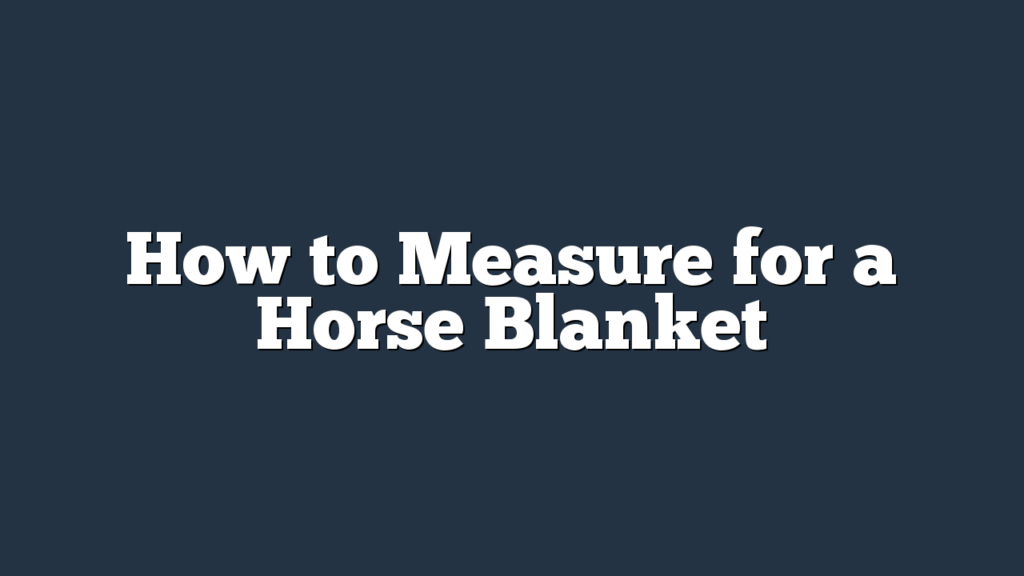Are you unsure how to measure for a horse blanket? Don’t worry, we’ve got you covered!
In this article, we’ll show you the step-by-step process of measuring your horse for the perfect fit.
From gathering the necessary tools to double-checking the measurements, you’ll learn everything you need to know to select the appropriate size.
So grab your measuring tape and let’s get started!
Gathering the Necessary Tools
To accurately measure for a horse blanket, you’ll need to gather up the necessary tools. Having the right tools will ensure that you get an accurate measurement and find the perfect fit for your horse. Here are some measuring techniques and tips to help you along the way.
Firstly, you’ll need a measuring tape. This is essential for getting precise measurements of your horse’s body. Make sure the measuring tape is flexible and long enough to measure the length and width of your horse.
Next, you’ll need a sturdy and flat surface to work on. A clean and level ground or a large table will suffice. This will provide a stable platform for you to take the measurements.
Additionally, you may want to have a helper or assistant with you. They can help hold the measuring tape in place and keep your horse calm and still during the process. It can be challenging to measure a horse on your own, so having an extra set of hands is beneficial.
Lastly, ensure that you have a notepad and pen to record the measurements. This will help you keep track of the measurements and make it easier when it comes time to purchase the horse blanket.
Measuring the Horse’s Length
To measure your horse’s length accurately, you’ll need a tape measure or a piece of string.
Start at the withers, the highest point of the horse’s shoulder, and measure all the way to the tail.
Make sure to account for the length of the tail as well, as this will affect the size of the blanket you need.
Tape or String
Measure your horse’s length by using a tape or string. When measuring, it’s important to account for your horse’s winter coat, as this can add extra bulk and affect the fit of the blanket.
To get an accurate measurement, you should measure from the center of the chest, where the base of the neck meets the chest, all the way to the point of the buttocks. Make sure the tape or string follows the contours of your horse’s body without sagging or pulling too tightly.
If you plan on using a blanket liner with your horse’s blanket, take this into consideration and measure accordingly. This will help ensure a proper fit and maximum comfort for your horse during the colder months.
Start at Withers
As you continue measuring for your horse blanket, start at the withers, where the base of the neck meets the back, to determine the length needed for a proper fit. This is an important step because the length of the blanket should cover the horse’s body from the withers to the tail.
To ensure accuracy and account for movement, follow these steps:
- Place one end of the measuring tape at the base of the withers.
- Extend the tape along the horse’s body, following the natural curve of the spine.
- Stop at the point where you want the blanket to end, usually at the tail.
- Take note of the measurement and round it up to the nearest even number to find the appropriate size.
Account for Tail Length?
Continue the measurement process by accounting for the length of the horse’s tail. When measuring for a horse blanket, it’s important to consider the tail length to ensure a proper fit. Tail length considerations are particularly important if you plan on using a blanket with a tail flap. The tail flap provides additional protection for the horse’s tail, but it can only do its job effectively if it’s the right length.
To measure for a tail flap, follow these simple steps:
- Position your horse with its tail relaxed and hanging naturally.
- Measure from the point where the blanket will end at the top of the tail to the tip of the tail bone.
- Record this measurement in inches or centimeters.
Determining the Horse’s Chest Circumference
To accurately determine your horse’s chest circumference for measuring a horse blanket, start by using a flexible measuring tape. Here’s how you can measure the chest circumference of your horse:
- Stand on the left side of your horse, facing forward.
- Place the measuring tape at the widest part of the horse’s chest, just behind the front legs.
- Wrap the measuring tape around the horse’s chest, ensuring that it’s snug but not too tight.
- Take note of the measurement in inches or centimeters.
When measuring the horse’s chest circumference, it’s important to consider girth variations and the fit of the blanket. Horses come in different shapes and sizes, so it’s crucial to choose a blanket that fits properly. If the blanket is too tight around the chest, it can restrict movement and cause discomfort. On the other hand, if the blanket is too loose, it may slip and cause irritation.
By accurately measuring your horse’s chest circumference and considering girth variations and blanket fit, you can ensure that your horse stays comfortable and protected during colder weather.
Measuring the Horse’s Neck Size
To accurately measure the horse’s neck size for a horse blanket, you’ll need a flexible measuring tape. Measuring the neck size is crucial to ensure a proper fit and maximum comfort for your horse. It’s important to note that different breeds may have varying neck sizes, so adjusting for these differences is essential.
To measure your horse’s neck size, start by standing on the left side of your horse and hold the measuring tape at the base of the mane. Extend the tape along the crest of the neck, following its natural curve, until you reach the point where you want the blanket to sit. Make sure the tape is snug but not too tight around the neck.
Accurate measurements are vital for finding the right size blanket. A neck measurement that’s too small can cause discomfort and restrict the horse’s movement. On the other hand, a neck measurement that’s too large can result in the blanket sliding off or causing chafing.
Remember to measure your horse’s neck size accurately, adjusting for different breeds, to ensure a proper fit and maximum comfort. By taking the time to measure correctly, you can provide your horse with a well-fitting blanket that will keep them warm and cozy throughout the winter months.
Measuring the Horse’s Shoulder Width
To ensure a proper fit for your horse blanket, accurately measuring your horse’s shoulder width is crucial. Many people make the common mistake of measuring too high or too low, resulting in an ill-fitting blanket.
Additionally, it’s important to consider that different horse breeds may have varying shoulder widths, so adjustments may be necessary.
Importance of Accurate Measurements
Take note of the horse’s shoulder width by measuring from the point of one shoulder to the point of the other shoulder using a flexible measuring tape. Accurate measurements are crucial when fitting a horse blanket because they ensure a proper fit, which is essential for the horse’s comfort and well-being.
Here are four reasons why accurate measurements are important:
- Importance of proper blanket fit: A properly fitted blanket allows for freedom of movement without rubbing or chafing, preventing discomfort and potential injuries.
- Factors affecting blanket sizing: Each horse is unique, and factors such as breed, conformation, and weight can affect the size and shape of their body, making accurate measurements vital for finding the right fit.
- Preventing blanket slippage: Incorrectly sized blankets may slip or shift, causing potential hazards and discomfort for the horse.
- Optimizing blanket effectiveness: A well-fitted blanket ensures that the horse receives the full benefits of warmth and protection, providing them with the necessary comfort during colder weather conditions.
Common Measurement Mistakes
Measuring a horse’s shoulder width accurately is essential to ensure a proper fit for a horse blanket. However, there are common measurement mistakes that can lead to fitting issues.
One of these mistakes is inaccurate measuring techniques. It’s important to use a flexible measuring tape and measure the widest part of the horse’s shoulder. Avoid using a rigid ruler or measuring too high on the neck, as this can result in a blanket that’s too tight and restricts the horse’s movement.
Another common fitting issue isn’t taking into account the horse’s conformation. Different horses have different shoulder shapes, and a blanket that fits one horse perfectly may not fit another. It’s important to consider the individual horse’s body shape when measuring for a blanket to ensure a proper fit and prevent discomfort or rubbing.
Adjusting for Different Breeds
When adjusting for different breeds, you’ll need to consider the horse’s shoulder width to ensure a proper fit for the blanket. Breed specific considerations and adjusting for body shape are important factors to keep in mind. Here’s a simple guide to help you measure the shoulder width accurately:
- Stand beside your horse and measure from the highest point of the withers to the point of the shoulder. This will give you the shoulder width measurement.
- For wider breeds, such as Draft horses or Warmbloods, you may need to choose a blanket with a broader shoulder area to accommodate their width.
- Narrower breeds, like Thoroughbreds or Arabians, may require a blanket with a more fitted shoulder to prevent rubbing or slipping.
- Consider the horse’s conformation and muscle development. Some breeds have wider or more prominent shoulders, while others have narrower or sloping shoulders. Adjust the blanket fit accordingly.
Measuring the Horse’s Belly Circumference
To measure your horse’s belly circumference for a blanket, start by standing beside your horse and placing the measuring tape around their belly. This measurement is important to ensure that the blanket fits properly and provides the necessary coverage. When measuring, make sure the tape is snug but not too tight. Take note of the measurement in inches or centimeters, depending on the tape you’re using.
When accounting for weight gain or loss, it’s essential to re-measure your horse’s belly circumference regularly. Horses can gain or lose weight throughout the year, and their blanket size may need to be adjusted accordingly. A well-fitting blanket should allow for some adjustment to accommodate weight fluctuations.
Additionally, when considering sizing for different climates, it’s important to take into account the thickness of the blanket and the weather conditions in your area. If you live in a colder climate, you may need a thicker and more insulated blanket to keep your horse warm. On the other hand, if you live in a warmer climate, a lighter and more breathable blanket may be more suitable.
Measuring the Horse’s Hindquarters
To measure your horse’s hindquarters for a blanket, stand beside your horse and use a flexible measuring tape to determine the appropriate size. This step is crucial in ensuring a proper fit for your horse’s blanket. Here’s how you can measure your horse’s hindquarters:
- Start by placing the measuring tape at the point of the horse’s tail base. Hold the tape loosely but make sure it’s touching the skin.
- Extend the tape down the horse’s hindquarters, following the contour of the muscles and bone structure.
- Continue measuring until you reach the point where the horse’s hindquarters meet the top of its hind legs.
- Ensure that the tape isn’t too tight or too loose. It should be snug enough to provide an accurate measurement, but not so tight that it restricts the horse’s movement.
When measuring the hindquarters, it’s important to account for movement. Horses have a natural tendency to move, so you should allow some extra room in the blanket to accommodate their stride and range of motion.
Double-Checking the Measurements and Selecting the Appropriate Size
After measuring your horse’s hindquarters, it’s important to double-check the measurements and select the appropriate size for the blanket. Double-checking ensures accuracy and avoids any discomfort or restriction for your horse. When reviewing the measurements, take into account any potential weight gain your horse may experience.
Remember that horses can gain weight throughout the year, especially during the colder months when they may be less active. It’s better to choose a blanket that allows for some extra room rather than one that fits too snugly.
In addition to accounting for weight gain, it’s crucial to consider your horse’s movement. The blanket shouldn’t restrict your horse’s natural range of motion or impede their ability to walk, trot, or run comfortably. A properly fitted blanket will allow your horse to move freely without causing any rubbing or chafing.
To select the appropriate size, refer to the manufacturer’s sizing chart. Each brand may have slightly different measurements, so it’s essential to consult the specific chart for the blanket you’re considering. Pay attention to the length and width measurements, as well as the suggested weight range.
Frequently Asked Questions
How Do I Determine the Weight Range for Different Horse Blanket Sizes?
To determine the weight range for different horse blanket sizes, you need to accurately measure your horse’s dimensions. This will help you choose the right size or even get a custom fit.
Can I Use a Measuring Tape Instead of a Flexible Ruler to Measure My Horse’s Length?
Yes, you can use a measuring tape instead of a flexible ruler to measure your horse’s length. It’s convenient and will give you an accurate measurement for choosing the right size horse blanket.
What Should I Do if My Horse’s Measurements Fall Between Two Different Blanket Sizes?
If your horse’s measurements fall between two blanket sizes, you can make fitting adjustments. Try going up a size and using straps to secure the blanket properly. You can also consult a professional for guidance.
Is It Necessary to Measure My Horse’s Neck Size if I Plan on Using a Blanket With a Detachable Neck Cover?
If you plan on using a blanket with a detachable neck cover, measuring your horse’s neck size isn’t necessary. However, keep in mind the pros and cons of using a blanket with a detachable neck cover, and explore alternative options for keeping your horse’s neck warm without a blanket.
Are There Any Specific Considerations I Should Keep in Mind When Measuring a Pregnant Mare for a Horse Blanket?
When measuring a pregnant mare for a horse blanket, it’s important to consider her changing shape. Ensure the blanket provides enough room for her growing belly while still properly covering her back and sides.
Conclusion
In conclusion, accurately measuring your horse is crucial when selecting a blanket. By gathering the necessary tools and measuring the horse’s length, chest circumference, neck size, shoulder width, belly circumference, and hindquarters, you can ensure a proper fit.
Double-checking the measurements and selecting the appropriate size will help keep your horse comfortable and protected during colder weather.



